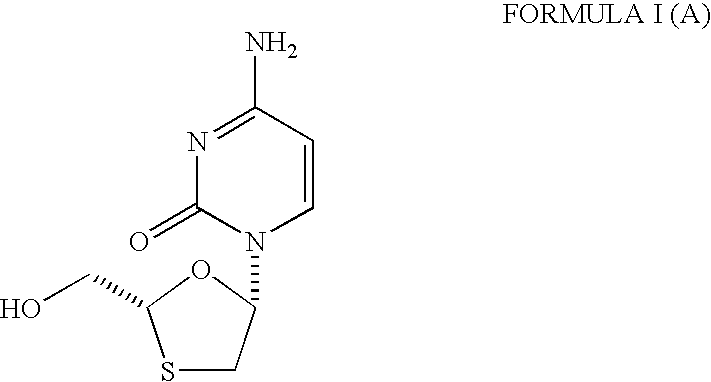Process and intermediates for the preparation of substituted 1,3-oxathiolanes, especially lamivudine
a technology of 1,3-oxathiolanes and intermediates, which is applied in the field of process and intermediates for the preparation of substituted 1,3-oxathiolanes, can solve the problems of inefficient preparing of said approach involving iodotrimethyl silane, and achieves high optical and chemical purity, good yield
- Summary
- Abstract
- Description
- Claims
- Application Information
AI Technical Summary
Benefits of technology
Problems solved by technology
Method used
Image
Examples
example 1
Preparation of (1R,2S,5R)-2-isopropyl-5-methylcyclohexyl (2R,5S)-5-[4-(acetylamino)-2-oxopyrimidin-1(2H)-yl]-1,3-oxathiolane-2-carboxylate
[0070]Step A: Methane sulfonic acid (0.5 mL) was added to a mixture of N-acetyl cytosine (100 g), hexamethyldisilazane (150 mL) and toluene (250 mL). The reaction mixture was refluxed till a clear solution was obtained.
Step B: Dimethylaminopyridine (9.5 g) was added to a solution of (1R,2S,5R)-2-isopropyl-5-methylcyclohexyl (2R,5R)-5-hydroxy-1,3-oxathiolane-2-carboxylate (190 g) and diphenylphosphinic chloride (190 g) in dichloromethane (600 mL) at 0° C. Diisopropylethylamine (119 g) was subsequently added slowly to the reaction mixture at −20° to −10° C. and stirred for 1 h at −20° to −10° C.
Step C: Triethylamine (86 g) was added to the solution obtained in Step A, followed by the addition of the reaction mixture obtained in Step B at reflux temperature. The reaction mixture was refluxed for 6 to 7 h, and cooled to about 25° C. The reaction mixtu...
example 2
Preparation of (1R,2S,5R)-2-isopropyl-5-methylcyclohexyl (2R,5S)-5-[4-(acetylamino)-2-oxopyrimidin-1(2H)-yl]-1,3-oxathiolane-2-carboxylate
[0072]Step A: Methane sulfonic acid (0.5 mL) was added to a mixture of N-acetyl cytosine (100 g), hexamethyldisilazane (150 mL) and toluene (250 mL). The reaction mixture was refluxed till a clear solution was obtained.
Step B: Dimethylaminopyridine (9.5 g) was added to a solution of (1R,2S,5R)-2-isopropyl-5-methylcyclohexyl (2R,5R)-5-hydroxy-1,3-oxathiolane-2-carboxylate (190 g) and diphenylchloro phosphate (215 g) in dichloromethane (600 mL). Diisopropylethylamine (145 g) was subsequently added slowly to the reaction mixture at 0° to 5° C. and stirred for 1 h at 0° to 5° C.
Step C: Triethylamine (86 g) was added to the solution obtained in Step A, followed by the addition of the reaction mixture obtained in Step B at reflux temperature. The reaction mixture was refluxed for 4 to 5 h, and cooled to 30° to 35° C. Methanol (100 mL) was added to the r...
example 3
Preparation of (1R,2S,5R)-2-isopropyl-5-methylcyclohexyl(2R,5S)-5-(4-amino-2-oxopyrimidin-1(2H)-yl)-1,3-oxathiolane-2-carboxylate
[0074](1R,2S,5R)-2-isopropyl-5-methylcyclohexyl(2R,5S)-5-[4-(acetylamino)-2-oxopyrimidin-1(2H)-yl]-1,3-oxathiolane-2-carboxylate (100 g) obtained from Example 2 was suspended in methanol (600 mL) at about 25° C. Methane sulfonic acid (29.4 g) was added drop-wise to the suspension in 15 to 20 minutes at 25° to 30° C. and stirred for 4 h at about 25° C. The reaction mixture was added slowly to a mixture of dichloromethane (1 L) and aqueous sodium bicarbonate solution (28 g of sodium bicarbonate dissolved in 1.2 L of water). The reaction mixture was stirred for 5 to 10 minutes and allowed to settle. The layers were separated and the organic layer was concentrated. Hexane (500 mL) was added to the residue and stirred for 2 h. The solid obtained was filtered and washed with hexane (100 mL), followed by isopropyl acetate (200 mL). The washed solid was dried at 4...
PUM
 Login to View More
Login to View More Abstract
Description
Claims
Application Information
 Login to View More
Login to View More - R&D
- Intellectual Property
- Life Sciences
- Materials
- Tech Scout
- Unparalleled Data Quality
- Higher Quality Content
- 60% Fewer Hallucinations
Browse by: Latest US Patents, China's latest patents, Technical Efficacy Thesaurus, Application Domain, Technology Topic, Popular Technical Reports.
© 2025 PatSnap. All rights reserved.Legal|Privacy policy|Modern Slavery Act Transparency Statement|Sitemap|About US| Contact US: help@patsnap.com



